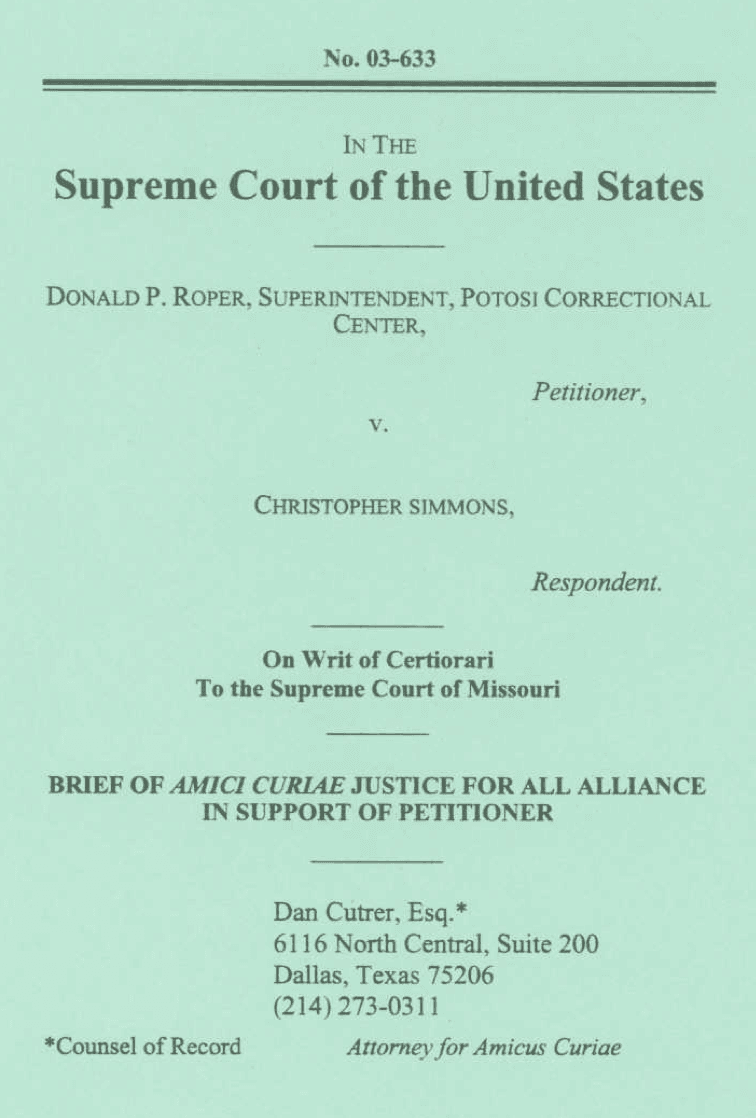
Summary of Argument
The issue before the Court is whether the execution of a person who committed premeditated murder while under the age of eighteen constitutes "cruel and unusual punishment" in violation of the Eighth Amendment to the Constitution of the United States of America.
The Court is using the national standards of decency doctrine in a way that ignores what punishment society really deems acceptable and appropriate because it does not apply the criteria that is reflected through state legislation and defined by the Court as what factors dictate whether punishment is cruel and unusual. The time has come for the Court to adopt as federal law the clear objective criteria it has defined over the past century evolving out of state legislation to determine what punishment constitutes cruel and unusual under the Eighth Amendment. The Court should require all states to apply the criteria on a case-by-case basis focusing on the moral culpability of the defendant.
The foundation of our judicial system is based on moral culpability. In intentional torts and criminal law the judicial system requires a requisite mental state in order to convict one of a crime. In criminal law, specifically murder cases, punishment is imposed according to one's degree of mens rea. In fact, one of the rationales for imposing the death penalty, deterrence, is directly linked to one's moral culpability because the threat of death prevents one from forming the intent to kill. The ultimate penalty is imposed on those who intend to kill, understand right from wrong and the consequences of their actions at the time of the act and nevertheless kill another human being.
Juveniles are capable of understanding right from wrong and the consequences of their actions. Furthermore, they are capable of forming the requisite intent to kill to merit the death penalty. They are also capable of being deterred from forming the requisite intent as will be illustrated in the analysis of the instant case.
The Court and a majority of state legislatures have held that individual consideration is a constitutional requirement before sentencing one to death. The Court needs to abide by this requirement and not group juveniles together as a class based on age. Rather, it should recognize that juvenile defendants, even those in the same age group, are shaped by individual life experiences and therefore possess different levels of maturity and make different choices. Consequently, their decisions affect their moral responsibility for a crime. This will be illustrated by looking at the similarities of Thompson, Wilkins, and Stanford and contrasting their moral culpability to that of Lee Malvo in the sniper case. What is reflected is that a fifteen, sixteen, and seventeen-year-old can be morally culpable to merit the death penalty. To ascertain the issue, a case-by-case analysis is required.
The Court should not focus solely on the states that expressly prohibit the execution of anyone under the age of 18 to decide if there is a national consensus. Rather, the Court should both consider and recognize that there is a national consensus among state legislatures to impose the death penalty on a defendant who did not intend to kill, nor killed, but was a major participant in a felony murder who knew that death was likely to occur. Clearly, this indicates that society deems it acceptable to impose the death penalty on a seven-teen-year-old that intended to kill and did in fact kill.
Executing the Respondent is not cruel and unusual punishment because he specifically knew it was wrong to kill, understood the consequences of his actions, and nevertheless committed a horrific premeditated murder of an innocent woman. His justification for the murder was that he knew his age would prevent him from receiving the ultimate punishment. Juveniles like Simmons, need to be deterred from committing such an egregious act for the safety of society by being properly punished. The Respondent's execution furthers the goals of the death penalty because he deserves his life be taken as a result of him intentionally taking an innocent woman's life. Furthermore, it sends a message to other juveniles that when one understands the repercussions, knows right from wrong and still commits premeditated murder, he or she will receive the ultimate penalty.